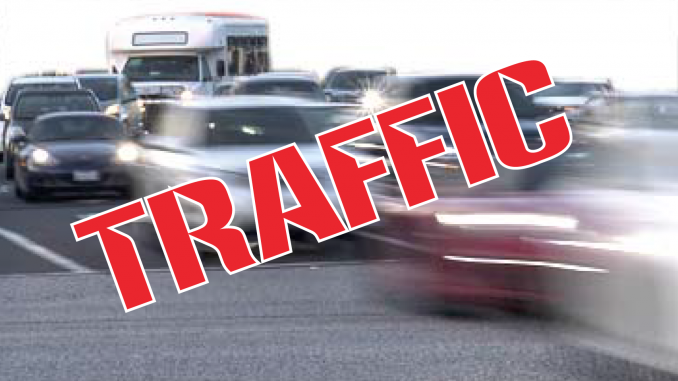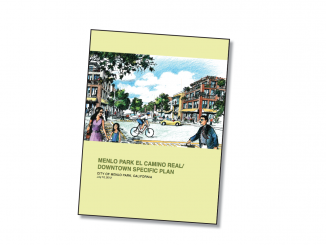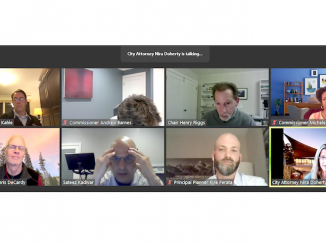
BY EMILY MIBACH
Daily Post Staff Writer
Some Menlo Park Planning Commissioners are wondering whether it is time to tell the City Council to halt development on the city’s east side because of worsening traffic.
“Any new buildings with new employees are more vehicles on the road,” Commissioner Katherine Strehl said at Monday’s meeting where the commission was reviewing plans for a five-story R&D building at 1350 Adams Court, located just east of where Facebook plans to build its massive Willow Village.
Tipping point
While there was no formal vote on the project, Strehl and her fellow commissioners, Henry Riggs and John Onken, contemplated at what point the commission should tell the council to hold off on approving more buildings in the area east of Highway 101.
The commissioners’ concerns stem from the lack of a citywide plan to diminish traffic in the area. Riggs pointed out at the commission’s Feb. 26 meeting where it reviewed the Facebook Willow plan that there are no plans in the pipeline to improve the area’s streets or reduce traffic.
“It’s difficult to say if this (project) is what breaks the camels back,” said Onken. “At what point do we say we have reservations that because of the traffic situation we can’t support a project of this size?”
Trapped in driveways
Onken and Riggs both pointed out that residents of the Willows and Belle Haven neighborhoods are already speaking out about the traffic that traps them on their driveways at certain times of the day.
But despite the traffic concerns, the commission told Menlo Park-based developer John Tarlton and his Tarlton Properties that the building was well planned and would make a great addition to the area.
Strehl also mentioned that perhaps trip caps ought to be considered for this and other projects in the area.
Commissioner Larry Kahle also said the commission needs to really consider the traffic implications of a project when reviewing it.
Safeguards
But Commissioner Andrew Barnes didn’t express the same concern that development on the east side ought to be halted, saying the area’s zoning plan will hold developers accountable for creating and maintaining good transportation plans that cut down on single car trips.
Tarlton’s project will be 91 feet tall, have 371 parking spaces and 260,400 square feet of research and development space.
It’s one of a handful of projects for the area in Menlo Park east of Highway 101.
The biggest is Facebook’s Willow Village, which will replace the 54-acre former Prologis site with office space, housing, a grocery store and pharmacy. Biotech company CS Bio may be bringing revamped plans for its campus at 1075 O’Brien Drive.
In August the city’s planning commission told Jason Chang, chief operating officer of CS Bio, to go back to the drawing board and shrink his proposal for a 110-foot building. The building would house his growing company that specializes in producing peptides, which are used in researching and developing new pharmaceuticals, such as a Type 2 diabetes treatment.




They’re worried about traffic but they’ll approve one more development? How about they put everything on hold until they solve the traffic problem? We reached the tipping point long ago!!
Willow Road should be declared a disaster area. It’s gridlocked in the afternoon. The cars just back up at the stoplights and barely move when they turn red.
I agree with the commissioners that think Menlo ought to halt approving any more development until there is a comprehensive traffic plan and mitigation to address the problems that the residents of the Willows and Belle Have have been experiencing. I am not sure why Andrew Barnes does not understand this. He is a resident of the Willows and knows the pain that some of us on more traveled streets have been going through.
Traffic is crazy and the city needs to stop approving developments until something is done.
I still think that a side-running bikeway would be better. Driveways aren”t unsafe because they are mostly private, so people rarely go in and out of them. Driveways are also usually narrow, so people go very slowly when entering and exiting them. Also, why not just make the protected bike lane a narrow “shared space area on both sides of the street, which prioritizes pedestrians and bicyclists, only allowing access to cars in one direction when these cars are accessing driveways. Where there were not frequent driveways, cars could be banned in the protected pedestrian/bike area. This approach is used in the Netherlands and in China, and it works, at least in areas that are not extremely busy. The advantage of this approach is that you have a wide, well-protected calmer area on the side of the road to bike and walk in, and you don”t have frequent breaks in protection to accommodate driveways.